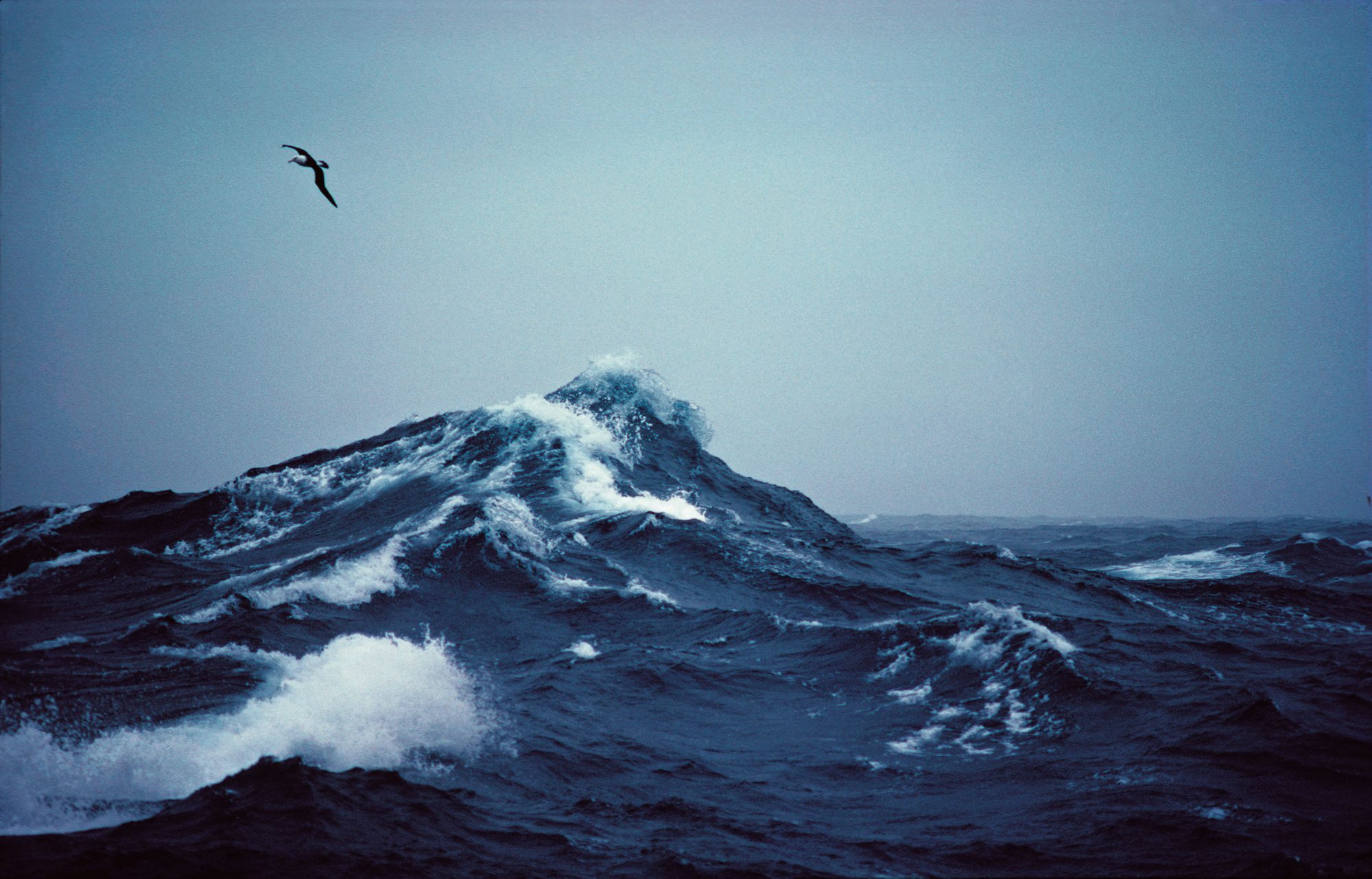
In Harm’s Way
Though justly famous for its flightless birds, New Zealand has also been called the seabird capital of the world. More species of albatross (and petrel and cormorant and penguin) are found in its waters than in those of any other country. Despite declines in albatross numbers worldwide, blamed largely on commercial fishing, Kiwi research, innovation and example is helping secure a brighter future for these iconic birds.
And through the fog came the yacht Mahalia, sliding down grey ocean swells, steaming for the Pyramid. The gale that had kept us in port for three days in the Chatham Islands had blown itself out, and banks of sea mist lolled in its wake. We passed the Fort, the Castle, the Murumurus and other southern islands of the Chathams. A fogbow formed on the horizon, and through its bright arch albatrosses rose and fell in an endless rollercoaster glide.
Ahead, the mist thinned to reveal a fang of rock rearing 176 m out of the sea: the Pyramid, or Tarakoikoia, a privately owned island which is the sole breeding site of the Chatham albatross. Around its shrouded summit the stately birds wheeled by the hundreds, their plangent wails and strange kazoo-like cackles echoing off the black volcanic slopes.
Mahalia’s skipper, Mark Jones, a wildlife photographer whose work with Tui De Roy has appeared in several issues of New Zealand Geographic, lowered an inflatable dinghy and ferried me ashore. Fur seals roused themselves to watch our approach, then, taking fright, heaved themselves off the rocks and tobogganed into the sea.
“Watch where the seals land and go the same way,” a Chatham Island fisherman had advised me. Jones positioned the inflatable against a barnacled rock face—no mean feat in the 2 m swells—and at the top of a wave I jumped, gripping the rubbery stalks of bull kelp and pulling myself up to a jumble of boulders. Sidestepping fetid pools where seals had been lying, I scrambled and rock-hopped my way up to the only level part of the island, an area about the size of a tennis court. Here ornithologist Paul Scofield and his assistant, Filipe Moniz, had pitched their tents, anchoring them with sturdy fish hooks wedged into crevices in the rock.

A few metres away, a partly fledged Chatham albatross chick stood up on its pedestal nest, yawned and shook its shaggy wings. Wisps of down fell from its plumage like fluff from a fur coat that had seen better days. The bird flumped back down with the stoical look one might expect from a creature that had sat on a peat chimney pot for three months, and had another month or two to go.
Pity the chicks of the so-called “great albatrosses”—the royal and wandering albatrosses—which are nest-bound for nine months during a breeding cycle that takes almost a whole year to complete. Spare a thought for their parents, too, who provide a non-stop meals-on-wings service for the entire chick-raising period; a task so demanding the pair takes a year off before breeding again.
Around the Pyramid colony, adult albatrosses were landing with a whoosh, bringing meals of slurrified seafood to their perpetually hungry offspring. One alighted near the tents, and Scofield and Moniz each picked up a shepherd’s crook and angled towards it. Sensing danger, the bird tried to take off, wings outstretched as it ran across the rocks with Moniz in close pursuit. A swipe with the crook, a bleat of protest, and the albatross was apprehended, snagged by the neck.
Moniz cradled the bird, keeping a tight grip on its devilishly hooked bill, while Scofield taped a popsicle-sized GPS logger to feathers between its shoulders, spray-painted its snowy chest with a slash of blue for ease of recognition, and released it. It pattered back to its nest, appeared to consider its options for a few moments then soared away. “One down, 11 to go,” Scofield said. Over the three weeks he and Moniz were planning to stay on the Pyramid, they hoped to deploy the devices on a dozen breeding adults to track their movements at sea.

Scofield, curator of vertebrates at Canterbury Museum and co-author of the recently published Albatrosses, Petrels and Shearzoaters of the World, has been studying albatrosses for 20 years. To research these iconic birds is to commit oneself to months at a time on the isolated, storm-lashed but utterly spectacular specks of land on which they breed: from the Crozet Islands in the Indian Ocean, to South Georgia in the South Atlantic, to New Zealand’s own subantarctic islands—Bounty, Antipodes, Auckland, Campbell, the Snares. Scofield has visited most of them.
The work is not without its risks. In 1985, the yacht taking Scofield to Marion Island in the Indian Ocean was rolled twice and dismasted 1100 km south of South Africa. Jury-rigged, the yacht limped to its destination. Scofield and the crew stayed there with other researchers for five months (they had planned on two days) while waiting for a ship to pick them up Another time, during a ferocious storm in the Chathams, Scofield and his colleagues had to wear safety harnesses bolted to the rock as they slept in their tents, in case a wave washed over their campsite. The wind was so strong it bowled eggs and even adult albatrosses off their nests. Scofield observed more than one parent try to push an egg back onto the nest with its bill—a challenge analogous to rolling a rugby ball up a flight of steps with your nose.
Despite the challenges, Scofield and other seabird scientists return year after year to their field studies, gathering the data that may ultimately save some species from extinction. Albatrosses are among the most threatened families of birds on earth. All but two of the 21 albatross species recognised by the International Union for the Conservation of Nature are described as vulnerable, endangered or, in the case of the Amsterdam and Chatham albatrosses, critically endangered. For the birds and those that study them, it is a race against time.
[Chapter-Break]
Albatrosses are among the largest of seabirds. Even the smaller species, called mollymawks, have 2 m wingspans, while the royals and wanderers, which weigh up to 10 kg, spread their wings 3 m or more—the greatest span of any living bird. These are the birds of legend: the peregrinating souls of drowned sailors, the harbinger of fair breezes, and the metaphor for penance in Samuel Taylor Coleridge’s Rime of the Ancient Mariner—“Ah! well-a-day! what evil looks / Had I from old and young! / Instead of the cross, the Albatross / About my neck was hung.” They are birds of mystery, too. In Moby-Dick, beholding a captured albatross, Ishmael muses: “Through its inexpressible, strange eyes, methought I peeped to secrets which took hold of God.”
Albatrosses are the undisputed masters of soaring flight, able to glide over vast tracts of ocean without flapping their wings. So fully have these birds adapted to their aerial existence that they spend the first six or more years of their long lives (which last upwards of 50 years) without touching land. With the exception of three North Pacific and one equatorial species, albatrosses are birds of the Southern hemisphere, and spend the greater part of their lives crisscrossing the stormy Southern Ocean. Thirteen species breed in New Zealand waters.
Everything about the lives of albatrosses underscores the difficulty of eking out an existence from the surface of the sea. The lengthy albatross “chickhood”—those long months spent surveying the world from a pedestal—is an adaptation to a patchy food supply: a slow-maturing chick needs food less often than a fast-maturing one. Similarly, the prolonged adolescence—up to 12 years in wandering albatrosses—is an extended education during which birds prospect the oceans,learning where and when to find food.
Because it takes so long for the birds to start reproducing, albatross populations are keenly vulnerable to threats on their breeding islands. Introduced predators such as rodents and feral cats (native land mammals are uniformly absent on albatross islands) pose a danger, especially to defenceless chicks, which are left alone for long periods while their parents shuttle back and forth from distant feeding grounds. In one of the most extreme examples of seabird predation, mice on Gough Island, in the South Atlantic, are decimating the populations of petrels and albatrosses that breed there, killing an estimated 1000 Tristan albatross chicks a year.
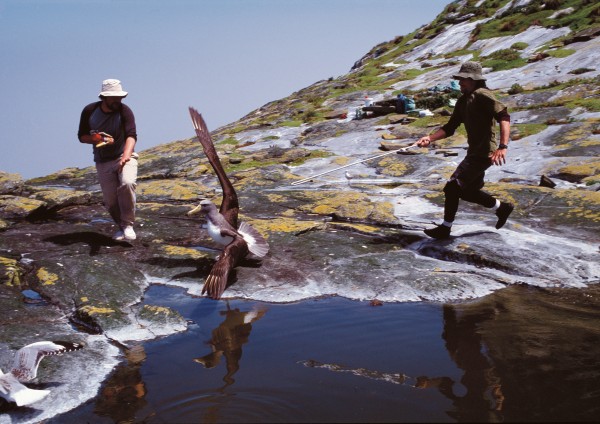
![Vig+10_SH[12_4]_ACl_2050_Cbot-_G+B+___816_L[6_250]_C[bot+_top-]_ Storms pose a considerable hazard to breeding albatrosses, most of which nest on high-latitude islands wracked by gales. In the wake of a storm in the early 1990s, photographer Kim Westerskov snapped this bedraggled northern royal albatross parent trying to rescue its egg on the Sisters, another albatross island in the Chathams group.](https://images.nzgeo.com/1970/01/egg-600x418.jpg)
Yet the most pernicious threats to albatrosses today are not to chicks but to adult birds. Along with other seabirds, they are locked in a competitive battle with humankind for the food resources of the sea—and the birds are losing. This is not just because of the efficiency of modern fishing practices but because fishing equipment—hooks, nets and trawl wires—inflicts a heavy toll of injury and death.
John Croxall, a seabird scientist with the British Antarctic Survey, has described the decrease in numbers in some species as “catastrophic.” Given the role of fisheries in their decline, he says, knowledge of the birds’ distribution and foraging patterns is “critical to their conservation.”
Scofield’s tracking work on the Pyramid has shown that Chatham albatrosses spend a lot of time foraging on the Chatham Rise, one of New Zealand’s richest fishing grounds. Orange roughy is fished here, as are several other deepwater species that form the backbone of New Zealand’s fishing industry. And here the big birds come to grief. Mastery of flight and navigation does not keep these supreme aerialists out of harm’s way”.
[Chapter-Break]
In this Wellington autopsy room, ornithologist Chris Robertson took a scalpel and slit open a plastic bag containing a white-capped albatross. The swan-sized carcass had been thawing for several days. Along with dozens of other seabirds in Robertson’s freezers, it had been collected at sea for the government’s fisheries science programme.
Robertson carefully unfolded the wings—wings that would have carried this albatross halfway around the world, between its breeding colony in the Auckland Islands and its feeding grounds in South African seas.
I flinched as I saw a raw wound at the elbow joint. Feathers and skin had been rasped down to bare bone. Had this bird, in its excitement at seeing a net full of squid or fish come to the surface, collided with the trawl warp? Had grease on the wire stuck to the feathers and wrapped the wing around the wire, dislocating the elbow and sending the injured bird spiralling into the sea? Or had the bird been feeding on the surface, caught up in a frenzy of pecking and lunging at fish and squid fragments, and been struck by the advancing warp?
![816_SH[12_5]_C[bot+]_](https://images.nzgeo.com/1970/01/death-600x419.jpg)
There are no reliable figures for the number of seabirds killed per year through contact with commercial fishing operations, but estimates for the Southern Ocean are in the tens of thousands. Vessels in well-regulated fisheries such as New Zealand’s are required to mitigate their impact on seabirds and report any accidental deaths, but there is a large shadow fleet of illegal, unregulated and unreported (IUU) vessels answering to no one.
In recent years, New Zealand fishers have become vigorous advocates of what is called “seabird-smart fishing,” inventing and trialling an array of ingenious methods of reducing seabird bycatch, and spreading the word to foreign fishing fleets.
Skippers of large vessels typically employ a suite of mitigation measures. John Bennett, who longlines for Patagonian toothfish (a.k.a. Chilean sea bass) around Antarctica and for bluenose and ling in New Zealand waters for the Sanford group, uses noise cannons and bird-scaring (or tori) lines—long curtains of fluttering streamers which hang above the line as it is set—to keep the birds at bay. He also weights the lines so that they sink before birds can get at them, sets at night, when fewer birds are feeding, and uses a line jiggler to make the baits more difficult for hungry beaks to snatch.
Other measures that have been trialled by longliners include setting lines through an underwater chute (to keep them off the sea surface) and using thawed baits (which sink faster than frozen ones). Some fishers dye baits blue to make them harder for birds to see. A Kiwi twist on the underwater chute is an invention in development by Warkworth fisherman Dave Kellian, that operates like a giant sewing machine needle, delivering each bait (each “stitch,” as it were) to a depth of 10 m before releasing it.
![816_SH[12_5]_C[bot+]_ Albatrosses are attracted by the prospect of a free lunch—either the fish caught by commercial fishing vessels or the offal dumped off the back of the boat. But there’s a not-so-hidden cost.](https://images.nzgeo.com/1970/01/trawler-600x395.jpg)
Trawlers employ different approaches to seabird mitigation. One example is something called the Brady Bird Baffler, a system of weighted lines hanging from booms on each side of the stern. Looking like a giant wind chime, the baffler makes the stern of a boat seem larger than it actually is, causing birds to give it and the trawl wires a wide berth. The brainchild of New Zealand fisheries observer Keith Brady, its first incarnation used orange plastic traffic cones, which jiggled and swayed with the boat’s motion.
The device has led to a number of alliterative spin-offs, including the Acme Avian Avoider and the Carefree Cunning Contraption. The latter, devised by Christchurch trawlerman Chris Carey, clips over the trawl warps and makes them look, from a distance, like large, hairy caterpillars. The “contraption” makes the warps more visible to seabirds and brushes them away if they get too close.
It’s too early for any clear data on the true effectiveness of these devices, although reports from Ministry of Fisheries observers suggest that seabird deaths have reduced considerably.
Not all mitigation ideas have been successful, however. One notable failure was the Brigitte Bardot laser gun, a device developed by the French actress’s animal-welfare foundation to deter pigeons from nesting in belfries. A marine version was tested by a New Zealand boat, but the local seabirds proved less sensitive to the beam than Gallic pigeons had been. The skipper conducting the trial remarked that “paper darts would have been more effective.”
Another failed deterrent was the deployment of helium balloons during the setting of the line. Bennett, who was trialling the technique, said it was abandoned because he was “afraid the birds would laugh themselves to death.”
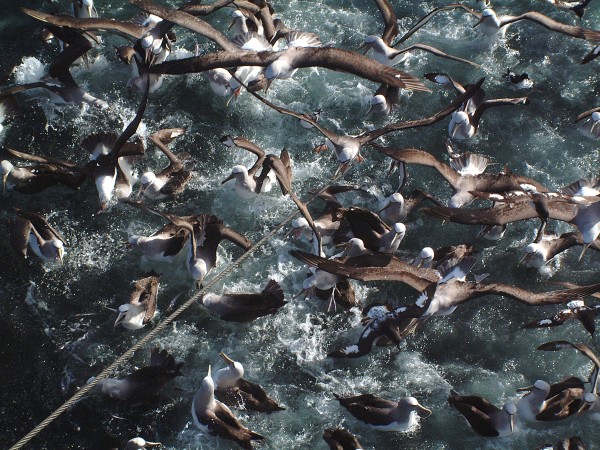

The long-term solution to seabird bycatch, says ornithologist Chris Robertson, is not to look for an infallible mitigation device but to remove the incentive for birds to come to the boat in the first place: to stop feeding them. Modern fishing vessels don’t just catch fish, they process it at sea, generating tonnes of offal, skeletons and scraps that have traditionally been dumped over the side. To a seabird, a vessel trailing a slick of such tidbits must look like a floating fast-food restaurant.
Turn the offal off, says Robertson, and you remove the fatal attraction. Malcolm McNeill agrees, and says that no birds have been caught by New Zealand toothfish vessels since 1999, because “nothing is put over the side of the boat.” He says he is convinced that “birds see our boats as multicoloured icebergs, not as a food source”.
Offal retention is a relatively simple matter for newer factory vessels, most of which are equipped with machinery to convert offal and scraps into fishmeal, for later sale. Older vessels without meal plants are generally not capable of holding more than an hour’s worth of discards. At the very least, such vessels can discharge their offal in batches (for a few minutes each hour, rather than trickling it out continuously) and not during setting or hauling, when the danger to birds is greatest.
The management of discards is a major aim of the Ministry of Fisheries. At present, the fishing industry has a voluntary code of practice in place for large deepwater vessels that includes both seabird mitigation measures and methods for controlling or eliminating offal discharge. But smaller vessels, and those in the near-shore fishery, aren’t part of that regulatory regime—yet their impact can be just as deadly. In 2007, a longline vessel fishing for ling and bluenose on the Chatham Rise caught 12 Chatham albatrosses and 22 Salvin albatrosses during a single voyage. Government is looking to establish a more comprehensive set of measures to which all fishers must comply.
“Managing offal is the key,” says Tom Chatterton, Ministry of Fisheries manager of deepwater issues. “If we can stop birds coming to the boats, we can stop them being caught.”
So, ideally, the discards cease—or are discharged when seabirds aren’t in the vicinity—and the birds lose interest in fishing boats. But they also lose their free lunch, which raises a thorny question: to what extent might fisheries be benefiting albatross populations?
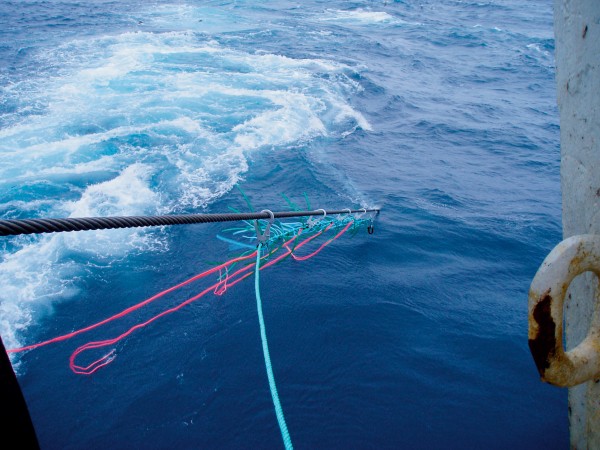
There is some evidence to suggest that a ready supply of fish scraps—essentially a seabird meal ticket—reduces competition for food between and within albatross species and provides an alternative food source to predatory birds such as skua, which often attack albatross chicks. A dietary study done by scientists Paul Sagar and Jean-Claude Stahl in the Snares Islands found that 70 per cent of the food that adult birds fed their chicks contained discards from nearby fisheries, resulting in a boost in the number of chicks that fledged.
This doesn’t mean that the industry be given “a conservation award for the thousands of seabirds it supports,” as one fisheries consultant has gamely suggested.
According to Stahl, in albatrosses—as with any long-lived, slow-maturing species with a low reproductive output—the long-term negative impact of adult mortality far outweighs the short-term benefit of greater chick survival. Albatross population models suggest that it may take three, four or even five successful chick rearings to compensate for the death of a single parent. Stahl calculates that “even small reductions in adult survival can wipe out the benefits of tonnes of discards fed to chicks.”
Scofield’s tracking of Chatham albatrosses shows that they, too, frequent the same fishing grounds as deep-sea trawlers, but not enough work has been done on the Chatham birds to compare the benefits of chick survival with the costs of adult deaths from fishing vessels. Nevertheless, Scofield thinks numbers could drop in this and other species when fishing vessels stop discarding their scraps. “It takes you back to a more natural situation,” he says, “but could easily lead to dramatic declines in seabird populations. We simply don’t know the degree to which we’re propping them up.”
Such is the complexity of natural systems that it is rarely possible to undo the effects of human interference without incurring an ecological cost. “Every time we fiddle with an ecosystem and change a factor we can make things a lot worse,” says Scofield. A classic example is single-species eradication of possums, which Scofield is convinced has led to a decline in blue ducks and other native birds. “Possums eat a lot of beech seeds and shoots, and when possums are cleared from an area, that food is added back into the system,” he says. “As a result, rats increase and stoats increase, and when the rats die back in winter, stoats switch prey to blue ducks.”
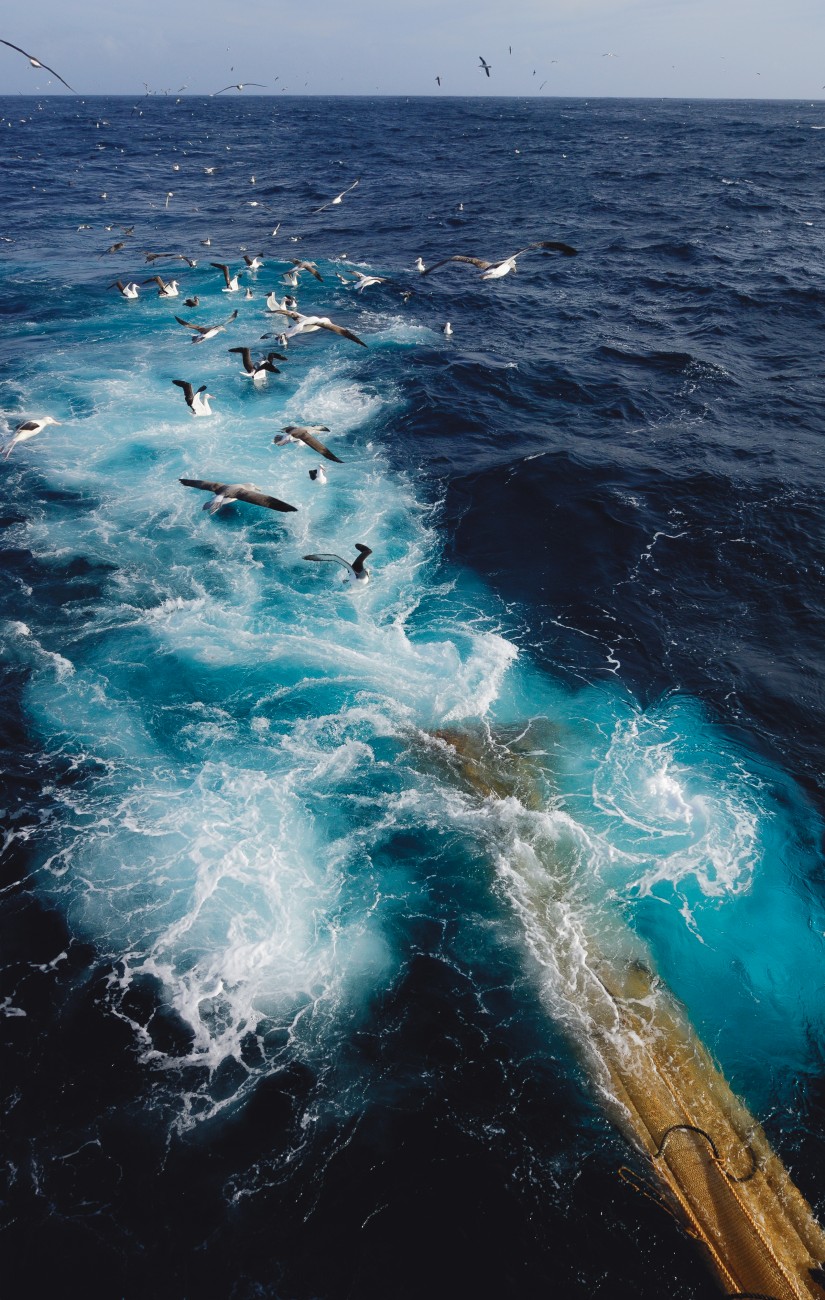
Populations can only be viewed as a whole and conserved as a whole, Scofield argues. It makes little sense to pursue total protection of adult birds from injury at sea if their chicks are being slaughtered by predators on land. In 1998, spilled fuel oil from the tanker Command fouled a section of California coastline and killed many birds, including sooty shearwaters. The shearwaters (also known as titi and muttonbirds) are trans-Pacific migrants that breed in New Zealand but over-winter in the Northern hemisphere, aggregating in huge flocks off the California coast. By funding rat eradication on breeding islands in New Zealand, a US conservation fund compensated for those and other deaths of adult birds by giving a massive boost to chick productivity on the other side of the earth.
Similarly, white-capped albatrosses—a species closely related to the Chatham albatross—have had some of their breeding colonies on the Auckland Islands destroyed by feral pigs. “If the fishing industry paid for the eradication of pigs, long-term it would more than compensate for the loss of birds to trawl warps,” says Scofield.
This idea of putting conservation funds to work where they will have the greatest positive impact has parallels with carbon offsetting, in which individuals, companies or countries mitigate their greenhouse emissions by, say, planting forests. The concept, termed “biodiversity offsetting,” was recently applied (albeit as a computer model) to seabird conservation. Researchers in Hobart and New York looked at a population of the flesh-footed shearwater, which, like many seabird species, is vulnerable both to fishery interactions at sea and to predation on land. They simulated the relative impact on the population of either banning fishing in the vicinity of its breeding island or using a bycatch levy to eradicate rats, and found that while both approaches led to a 60 per cent increase in annual growth rate over 20 years, the application of a bycatch levy on fishers cost only a sixth as much as the loss of earnings if fishing had been banned. Since as many as two-thirds of birds threatened by fishing are also threatened by invasive species, this offsetting approach would have wide applicability.
It’s an approach that underscores the connectedness of the living world—and, curiously enough, this is the central message of Coleridge’s Rime. In the poem, redemption for the woebegone mariner comes when he embraces all life, no matter how lowly. “He prayeth well who loveth well/ Both man, and bird, and beast.” It is a message that hasn’t lost its pertinence.

















